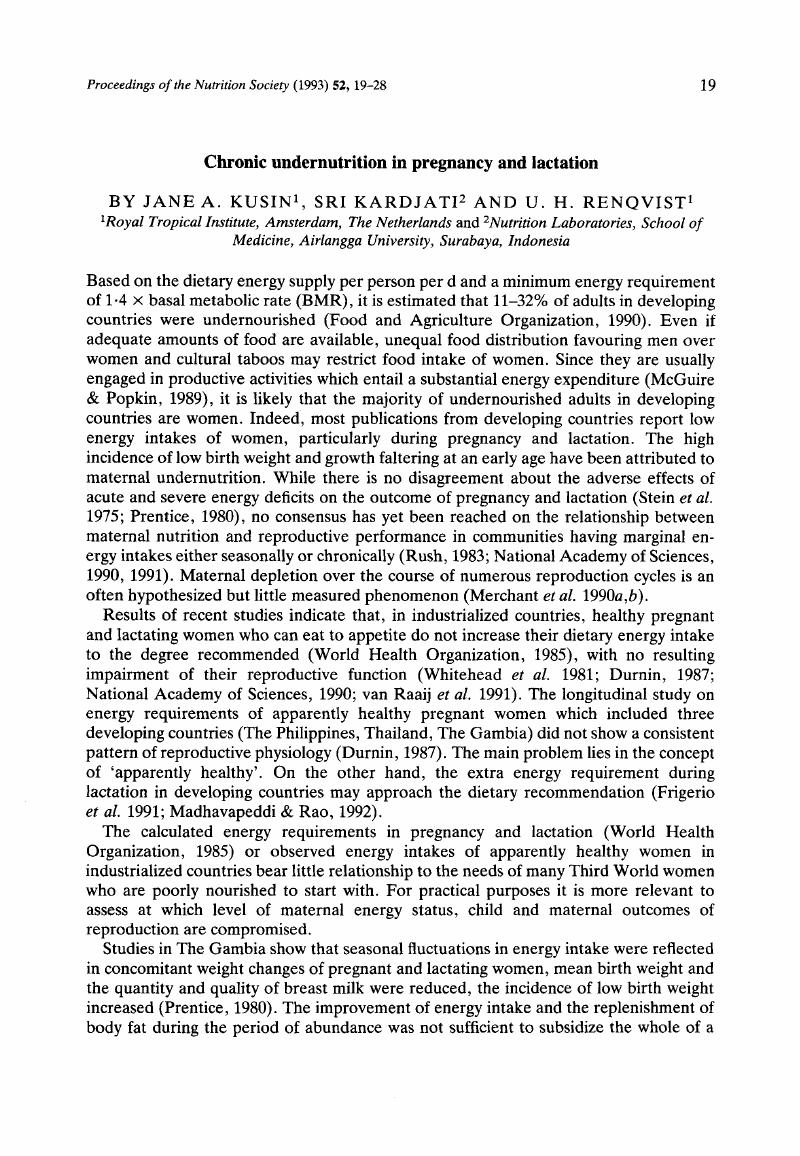Crossref Citations
This article has been cited by the following publications. This list is generated based on data provided by Crossref.
Winkvist, Anna
Jalil, Fehmida
Habicht, Jean-Pierre
and
Rasmussen, Kathleen M
1994.
Maternal Energy Depletion Is Buffered among Malnourished Women in Punjab, Pakistan1.
The Journal of Nutrition,
Vol. 124,
Issue. 12,
p.
2376.
Winkvist, Anna
Jalil, Fehmida
Habicht, Jean-Pierre
and
Rasmussen, Kathleen M
1994.
Maternal Energy Depletion Is Buffered among Malnourished Women in Punjab, Pakistan , .
The Journal of Nutrition,
Vol. 124,
Issue. 12,
p.
2376.
Dahri, S.
Reusens, B.
Remacle, C.
and
Hoet, J. J.
1995.
Nutritional influences on pancreatic development and potential links with non-insulin-dependent diabetes.
Proceedings of the Nutrition Society,
Vol. 54,
Issue. 2,
p.
345.
Anderson, Annie S.
Milburn, Kathryn
and
Lean, Michael
1995.
Food Choice and the Consumer.
p.
105.
1996.
Abstracts Of Communications.
Proceedings of the Nutrition Society,
Vol. 55,
Issue. 1A,
p.
1A.
Smith, Chery
1997.
The effect of maternal nutritional variables on birthweight outcomes of infants born to Sherpa women at low and high altitudes in Nepal.
American Journal of Human Biology,
Vol. 9,
Issue. 6,
p.
751.
Nurdiati, Detty Siti
Hakimi, Mohammad
Wahab, Abdul
and
Winkvist, Anna
1998.
Concurrent Prevalence of Chronic Energy Deficiency and Obesity among Women in Purworejo, Central Java, Indonesia.
Food and Nutrition Bulletin,
Vol. 19,
Issue. 4,
p.
321.
Caire, Graciela
de la Barca, Ana María Calderón
Bolaños, Adriana Verónica
Valencia, Mauro E.
Coward, Andy W.
Salazar, Gabriela
and
Casanueva, Esther
2002.
Measurement of Deuterium Oxide by Infrared Spectroscopy and Isotope Ratio Mass Spectrometry for Quantifying Daily Milk Intake in Breastfed Infants and Maternal Body Fat.
Food and Nutrition Bulletin,
Vol. 23,
Issue. 3_suppl1,
p.
38.
Winkvist, Anna
Stenlund, Hans
Hakimi, Mohammad
Nurdiati, Detty S
and
Dibley, Michael J
2002.
Weight-gain patterns from prepregnancy until delivery among women in Central Java, Indonesia.
The American Journal of Clinical Nutrition,
Vol. 75,
Issue. 6,
p.
1072.
Singh, Jarnail
2003.
Gastroschisis is caused by the combination of carbon monoxide and protein‐zinc deficiencies in mice.
Birth Defects Research Part B: Developmental and Reproductive Toxicology,
Vol. 68,
Issue. 4,
p.
355.
Winkvist, A
Rasmussen, K M
and
Lissner, L
2003.
Associations between reproduction and maternal body weight: examining the component parts of a full reproductive cycle.
European Journal of Clinical Nutrition,
Vol. 57,
Issue. 1,
p.
114.
Nakamoto, Tetsuo
2004.
Coffee, Tea, Chocolate, and the Brain.
Vol. 20043667,
Issue. ,
Singh, Jarnail
2006.
Interaction of maternal protein and carbon monoxide on pup mortality in mice: implications for global infant mortality.
Birth Defects Research Part B: Developmental and Reproductive Toxicology,
Vol. 77,
Issue. 3,
p.
216.
Jones, RL
Cederberg, HMS
Wheeler, SJ
Poston, L
Hutchinson, CJ
Seed, PT
Oliver, RL
and
Baker, PN
2010.
Relationship between maternal growth, infant birthweight and nutrient partitioning in teenage pregnancies.
BJOG: An International Journal of Obstetrics & Gynaecology,
Vol. 117,
Issue. 2,
p.
200.
Sealy, Yvette M.
Zarcadoolas, Christina
Dresser, Michelle
Wedemeyer, Laura
Short, Leslie
and
Silver, Lynn
2012.
Using Public Health Detailing and a Family-Centered Ecological Approach To Promote Patient–Provider–Parent Action for Reducing Childhood Obesity.
Childhood Obesity,
Vol. 8,
Issue. 2,
p.
132.
Leslie, Wilma S
Koshy, Preethi R
Mackenzie, Mhairi
Murray, Heather M
Boyle, Susan
Lean, Michael EJ
Walker, Andrew
and
Hankey, Catherine R
2012.
Changes in body weight and food choice in those attempting smoking cessation: a cluster randomised controlled trial.
BMC Public Health,
Vol. 12,
Issue. 1,
Coffey, Diane
2015.
Early life mortality and height in Indian states.
Economics & Human Biology,
Vol. 17,
Issue. ,
p.
177.
Castillo, H
Santos, I S
and
Matijasevich, A
2016.
Maternal pre-pregnancy BMI, gestational weight gain and breastfeeding.
European Journal of Clinical Nutrition,
Vol. 70,
Issue. 4,
p.
431.
Perrin, Caroline
Hounga, Lothaire
and
Geissbuhler, Antoine
2018.
Systematic review to identify proxy indicators to quantify the impact of eHealth tools on maternal and neonatal health outcomes in low-income and middle-income countries including Delphi consensus.
BMJ Open,
Vol. 8,
Issue. 8,
p.
e022262.
Bahwere, Paluku
Judge, Debra S.
Spencer, Phoebe
Chiwile, Faraja
Mutunga, Mueni
and
Shrestha, Dhruba
2024.
Examining the burden and relationship between stunting and wasting among Timor-Leste under five rural children.
PLOS ONE,
Vol. 19,
Issue. 10,
p.
e0312433.



